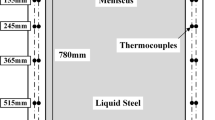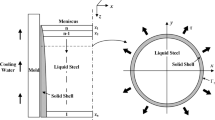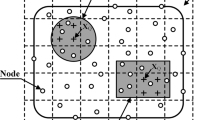Abstract
When dealing with coupled thermomechanical challenges, the conventional mesh-based numerical methods show significant disadvantages in solving the problems of dynamic tracking phase interface and imposition of ferrostatic pressure. In the present work, a thermo-elastic-plastic calculation model for continuous casting round billet is established based on the element-free Galerkin (EFG) method. In the plastic deformation stage, the Mises criterion with isotropic hardening is used to describe the correlation between the yield and strengthening functions. Considering that the material properties as a function of temperature and the plastic deformation will cause a nonlinear stress–strain relationship, the incremental approach is applied in the solution process. Besides, the correction scheme is used to improve the stress calculation precision in the elastoplastic transition zone. Taking advantage of measured heat flux as the boundary condition, the nonuniform heat transfer/solidification and mechanical behaviors of round billet were calculated and analyzed. The results show that the established EFG model achieves good calculation accuracy when dealing with nonlinear thermomechanical problems. The maximum equivalent stress appears within 1 mm beneath the shell surface in the initial stage of solidification, while the shell surface presents maximum equivalent stress at the mold outlet. A potentially sensitive area for cracks will appear at 50 to 100 mm below the meniscus. The research results are helpful in understanding the nonuniform heat transfer, mechanical, and crack behaviors of round billet, which could provide theoretical support for process design and quality optimization.









Similar content being viewed by others
Abbreviations
- \(p_{j} \left( {\varvec{x}} \right)\) :
-
Basis function (–)
- \(a_{j} \left( {\varvec{x}} \right)\) :
-
Undetermined coefficient (–)
- \(\Phi \) :
-
Shape function matrix (–)
- ϕ :
-
Shape function (–)
- k :
-
Thermal conductivity [W/(m·°C)]
- ρ :
-
Density (kg/m3)
- c :
-
Specific heat [J/(kg·°C)]
- L :
-
Latent heat (J/kg)
- f s :
-
Solid fraction (pct)
- T :
-
Temperature [K (°C)]
- c eff :
-
Effective specific heat [J/(kg·°C)]
- C :
-
Heat capacity matrix (–)
- K :
-
Heat conduction matrix (–)
- F :
-
Heat load vector (–)
- σ ij :
-
Stress tensor (–)
- b i :
-
Body force vector (–)
- ε ij :
-
Strain tensor (–)
- \({{\varvec{u}}}_{i}\) :
-
Displacement vector (–)
- \( {\varvec{\bar{u}}}_{i} \) :
-
Displacement components (–)
- \(\overline{\varvec{t}}_{i}\) :
-
Stress components (–)
- \({\mathbf{n}}_{j}\) :
-
Normal vector (–)
- \(d{\left\{{\varvec{\varepsilon}}\right\}}_{e}\) :
-
Elastic strain increments (pct)
- \(d{\left\{{\varvec{\varepsilon}}\right\}}_{p}\) :
-
Plastic strain increments (pct)
- \(d{\left\{{\varvec{\varepsilon}}\right\}}_{T}\) :
-
Thermal strain increments (pct)
- \(\left[{{\varvec{D}}}_{e}\right]\) :
-
Elastic stiffness matrix (–)
- \(\left[{{\varvec{D}}}_{p}\right]\) :
-
Plastic stiffness matrix (–)
- \(\left[{{\varvec{D}}}_{ep}\right]\) :
-
Elastoplastic stiffness matrix (–)
- m :
-
Elasticity factor (–)
- \(\left\{\boldsymbol{\alpha }\right\}\) :
-
Thermal expansion vector (–)
- \(\stackrel{\sim }{\alpha }\) :
-
Penalty coefficient (–)
- \( \bar{q} \) :
-
Measured heat flux (–)
- p f :
-
Ferrostatic pressure (–)
- \(g\) :
-
Gravity acceleration (m/s2)
- v c :
-
Casting speed (m/s)
- t :
-
Residence time (s)
- K c :
-
Amplification factor (–)
References
L. Zhang, H.F. Shen, T.Y. Huang, and B.C. Liu: Int. J. Cast. Met. Res., 2003, vol. 15, pp. 355–59.
G.R. Liu and Y.T. Gu: An Introduction to Meshfree Methods and Their Programming, 1st ed. Springer, Dordrecht, 2005, pp. 54–111.
J.C. Alvarez Hostos, A.D. Bencomo, and E.S. Puchi Cabrera: J. Therm. Stresses., 2017, vol. 41, pp. 160–81.
U. Hanoglu and B. Šarler: Comput. Struct., 2018, vol. 194, pp. 1–14.
U. Hanoglu and B. Šarler: Metals., 2019, vol. 9, pp. 788–808.
V. Hatic, B. Mavric, and B. Šarler: COUPLED VIII–Proc. Int. Conf. on Computational Methods for Coupled Problems in Science and Engineering, 2019, pp. 118–27.
B. Mavric and B. Šarler: COUPLED PROBLEMS–Proc. Int. Conf. on Coupled Problems in Science and Engineering, 2015, pp. 160–68.
M. Alizadeh, S.A.J. Jahromi, and S.B. Nasihatkon: ISIJ Int., 2010, vol. 50, pp. 411–17.
L. Zhang, Y.M. Rong, H.F. Shen, and T.Y. Huang: J. Mater. Process. Technol., 2007, vol. 192, pp. 511–17.
R. Vertnik and B. Šarler: Int. J. Cast. Met. Res., 2009, vol. 22, pp. 311–13.
R. Vertnik and B. Šarler: Eng. Anal. Bound. Elem., 2014, vol. 45, pp. 45–61.
L. Zhang, H.F. Shen, Y.M. Rong, and T.Y. Huang: Mater. Sci. Eng., 2007, vol. 466A, pp. 71–78.
R. Vaghefi, A. Nayebi, and M.R. Hematiyan: Acta Mech., 2018, vol. 229, pp. 4375–92.
G.R. Liu: Mesh Free Methods Moving beyond the Finite Element Method, CRC Press LLC, Boca Raton, 2002, pp. 53–265.
L.Q. Cai, X.D. Wang, N. Wang, and M. Yao: Metall. Mater. Trans. B, 2020, vol. 51B, pp. 236–46.
L.Q. Cai, X.D. Wang, M. Yao, and Y. Liu: Metall. Mater. Trans. B, 2020, vol. 51B, pp. 1113–26.
J.C. Álvarez Hostos, E.S. Puchi Cabrera, and A.D. Bencomo: Steel Res. Int., 2015, vol. 86, pp. 1403–18.
T. Belytschko, Y.Y. Lu, and L. Gu: Int. J. Numer. Meth. Eng., 1994, vol. 37, pp. 229–56.
C. Li and B.G. Thomas: Metall. Mater. Trans. B, 2004, vol. 35B, pp. 1151–72.
J.C. Alvarez Hostos, A.D. Bencomo, E.S. Puchi Cabrera, and I.M. FigueroaPoleo: Int. J. Cast. Met. Res., 2018, vol. 31, pp. 47–55.
R. Vaghefi, M.R. Hematiyan, A. Nayebi, and A. Khosravifard: Eng. Anal. Bound. Elem., 2018, vol. 89, pp. 10–24.
K. Schwerdtfeger, M. Sato, and K.H. Tacke: Metall. Mater. Trans. B, 1998, vol. 29B, pp. 1057–68.
B. Lally, L. Biegler, and H. Henein: Mater. Trans., 1990, vol. 21B, pp. 761–70.
H.B. Yin, M. Yao, H.Y. Zhan, and D.C. Fang: ISIJ Int., 2006, vol. 46, pp. 546–52.
Y.M. Won: ISIJ Int., 1998, vol. 38, pp. 53–62.
J.M. Risso, A.E. Huespe, and A. Cardona: Int. J. Numer. Meth. Eng., 2006, vol. 65, pp. 1355–77.
V.D. Fachinotti and A. Cardona: Int. J. Numer. Meth. Eng., 2007, vol. 70, pp. 728–55.
S. Koric and B.G. Thomas: Int. J. Numer. Meth. Eng., 2006, vol. 66, pp. 1955–89.
B.G. Thomas and J.T. Parkman: THERMEC 97–Int. Conf. Thermomechanical Processing of Steels and Other Materials, 1997, vol. 2, pp. 2279–85.
Acknowledgments
This work is supported by the National Natural Science Foundation of China (Grant No. 51974056/51474047). The Fundamental Research Funds for the Central Universities and the Key Laboratory of Solidification Control and Digital Preparation Technology (Liaoning Province) are also gratefully acknowledged. Part of this work was performed using computational resources from the Supercomputing Center, Dalian University of Technology.
Conflict of interest
On behalf of all the authors, the corresponding author states that there is no conflict of interest.
Author information
Authors and Affiliations
Corresponding author
Additional information
Publisher's Note
Springer Nature remains neutral with regard to jurisdictional claims in published maps and institutional affiliations.
Rights and permissions
About this article
Cite this article
Cai, L., Wei, J., Wang, X. et al. Thermomechanical Analysis of Continuous Casting Round Billet Based on the Element-Free Galerkin Method. Metall Mater Trans B 53, 1462–1473 (2022). https://doi.org/10.1007/s11663-022-02454-0
Received:
Accepted:
Published:
Issue Date:
DOI: https://doi.org/10.1007/s11663-022-02454-0




